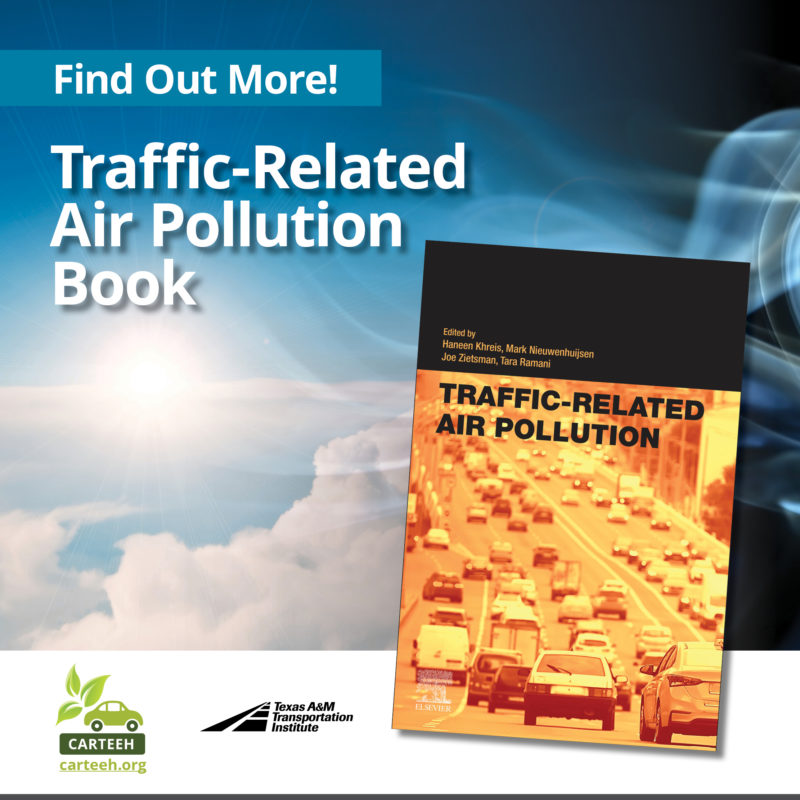 Researchers from TTI’s Center for Advancing Research in Transportation Emissions, Energy and Health (CARTEEH) published the 1st edition of Traffic-Related Air Pollution on Aug. 19, 2020. Associate Research Scientist Haneen Khreis led the editing of the book, working with CARTEEH Director Joe Zietsman and Associate Research Engineer Tara Ramani along with Mark Nieuwenhuijsen, a research professor at the Barcelona Institute of Global Health. This is the first published book of its kind on the topic of traffic-related air pollution (TRAP) and its impacts on human health, at the individual and population levels.
Researchers from TTI’s Center for Advancing Research in Transportation Emissions, Energy and Health (CARTEEH) published the 1st edition of Traffic-Related Air Pollution on Aug. 19, 2020. Associate Research Scientist Haneen Khreis led the editing of the book, working with CARTEEH Director Joe Zietsman and Associate Research Engineer Tara Ramani along with Mark Nieuwenhuijsen, a research professor at the Barcelona Institute of Global Health. This is the first published book of its kind on the topic of traffic-related air pollution (TRAP) and its impacts on human health, at the individual and population levels.
The book consists of 25 chapters led by global experts in a variety of topics related to TRAP and health, including mitigation standards and regulations regarding TRAP and public health. Included in this approach are methods and tools for assessing and quantifying road traffic, vehicle emissions, air pollution, human exposure, biological reactions and population-based health impacts.
To give a brief overview of the contents, Traffic-Related Air Pollution:
- Synthesizes state-of-the-art knowledge on TRAP and human health;
- Summarizes current and emerging tools to evaluate TRAP’s public health impacts;
- Examines the latest technologies and policies — while also addressing potential effectiveness and negative effects — for mitigating TRAP; and
- Demonstrates how teaching, practice and policymaking can connect with methods and tools to mitigate TRAP and its adverse health effects.
Traffic-Related Air Pollution is useful to different groups for different purposes. Public health experts and authorities can use the methods and tools in the book to better understand how TRAP can affect health and how to quantify these impacts tracking air pollution levels back to the responsible sources. Likewise, transportation planners and authorities can incorporate the book’s recommendations and best practices into design and planning efforts — especially useful for collaborating with public health experts and authorities. Specialists in environmental or health law and policy can become more informed on the connections between TRAP and public health, which in turn can lead to policymaking that mitigates TRAP’s adverse effects and provides tools to generate and assess a wider range of policy options worldwide.
Researchers and students in transportation and health can facilitate discussions with — and transfer knowledge between — colleagues in both fields about these issues and begin to identify potential solutions. The book is also intended as a resource for educators to train a cross-disciplinary workforce able to address multifaceted challenges at the intersection of transportation and health.
“Traffic-Related Air Pollution focuses on TRAP as one adverse, but modifiable, environmental exposure that significantly affects public health, especially in cities. The book sets real-world implications alongside policy options, emerging technologies, and best practices,” Khreis explains. “It provides recommendations on ways to engage in discourse and policy to better address TRAP’s health impacts and its real societal costs.”